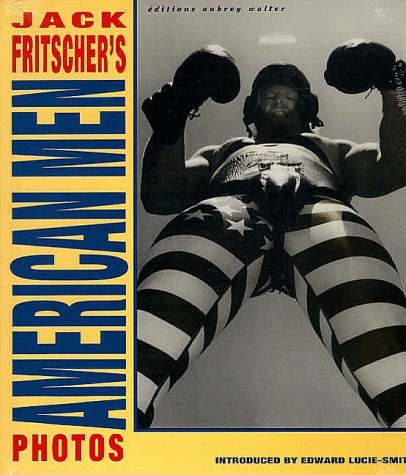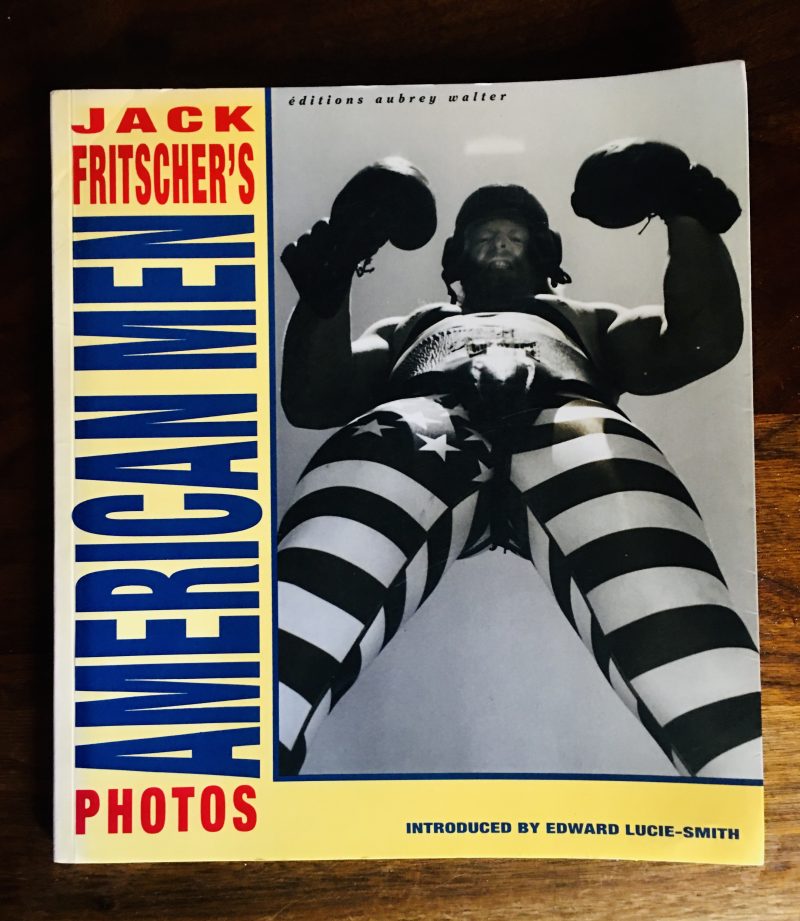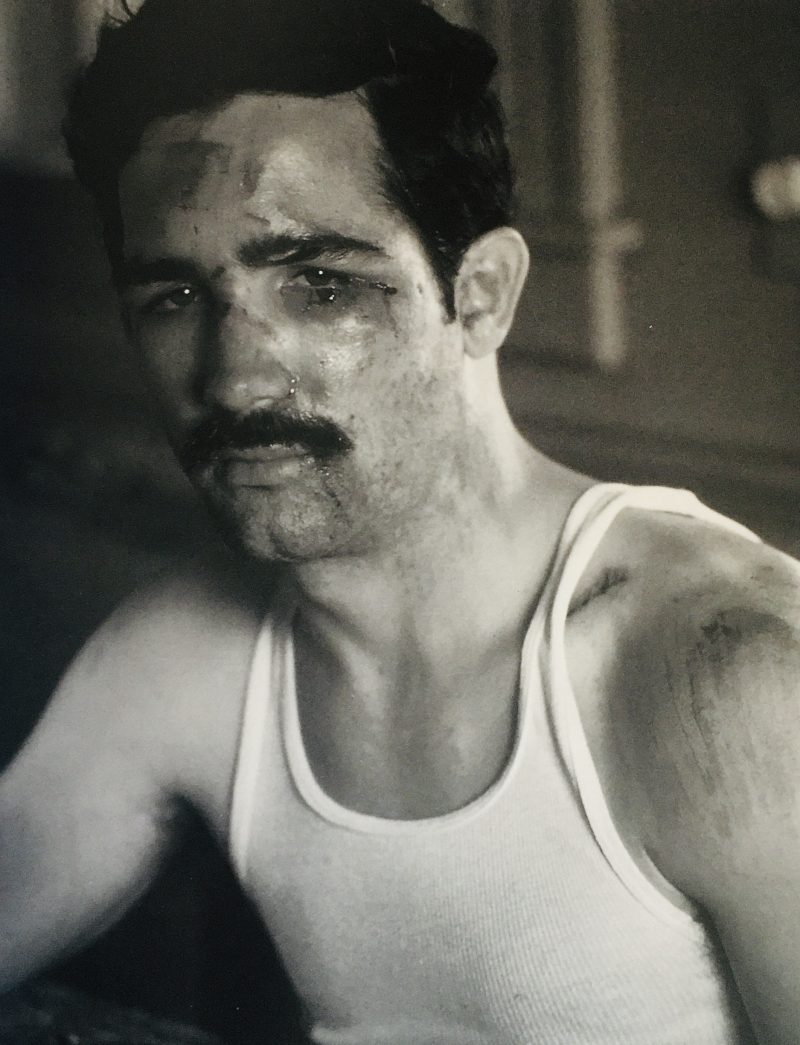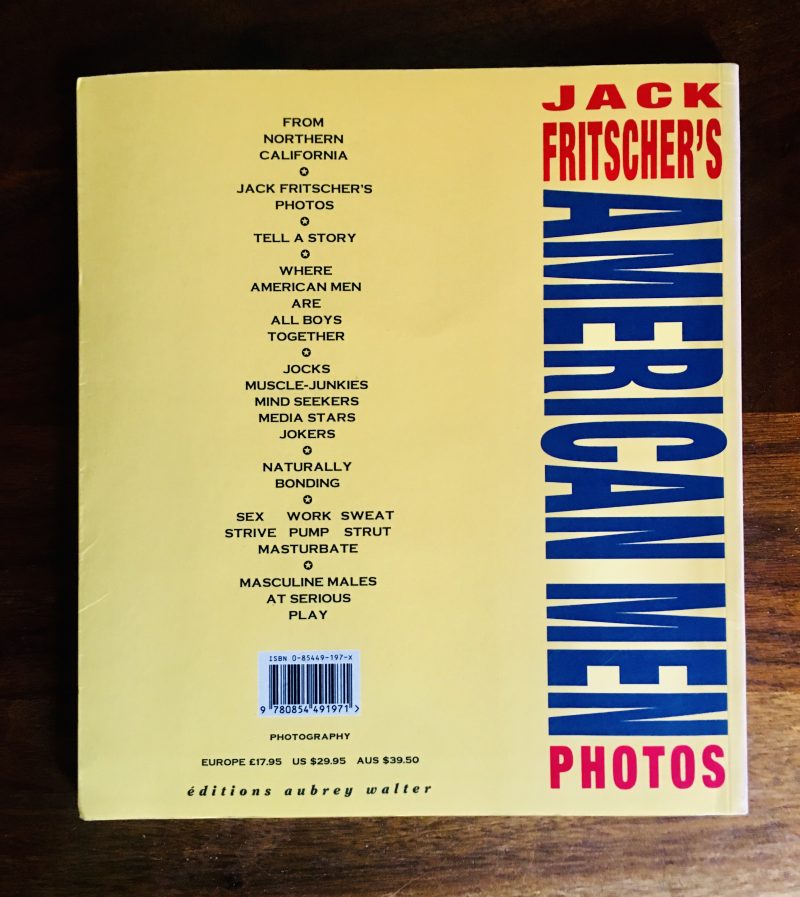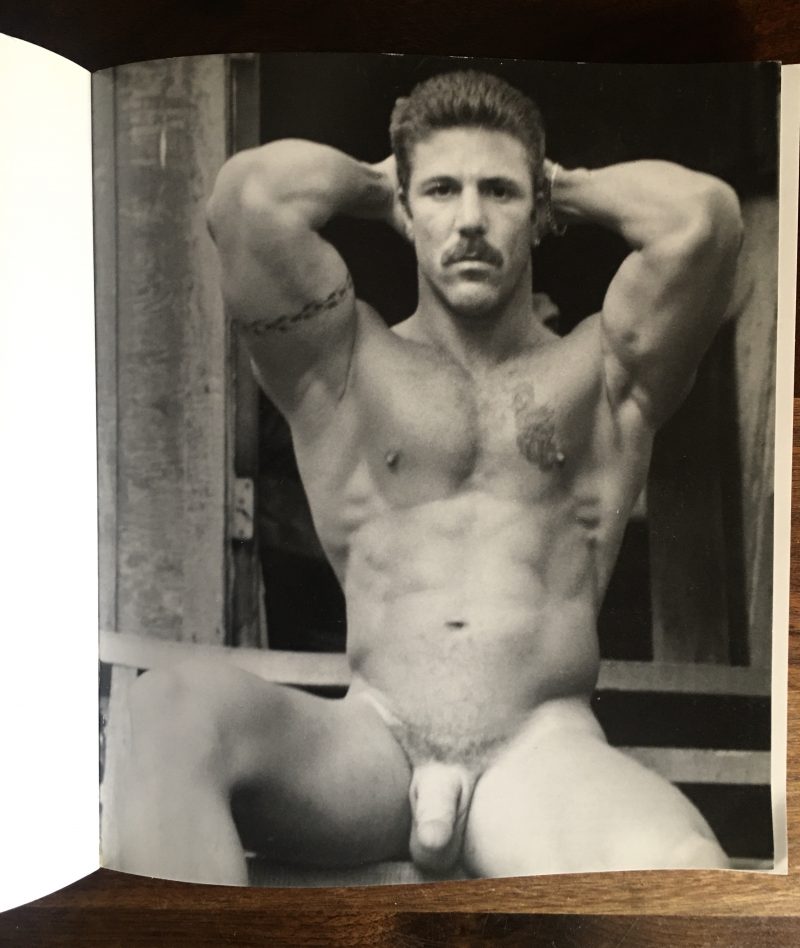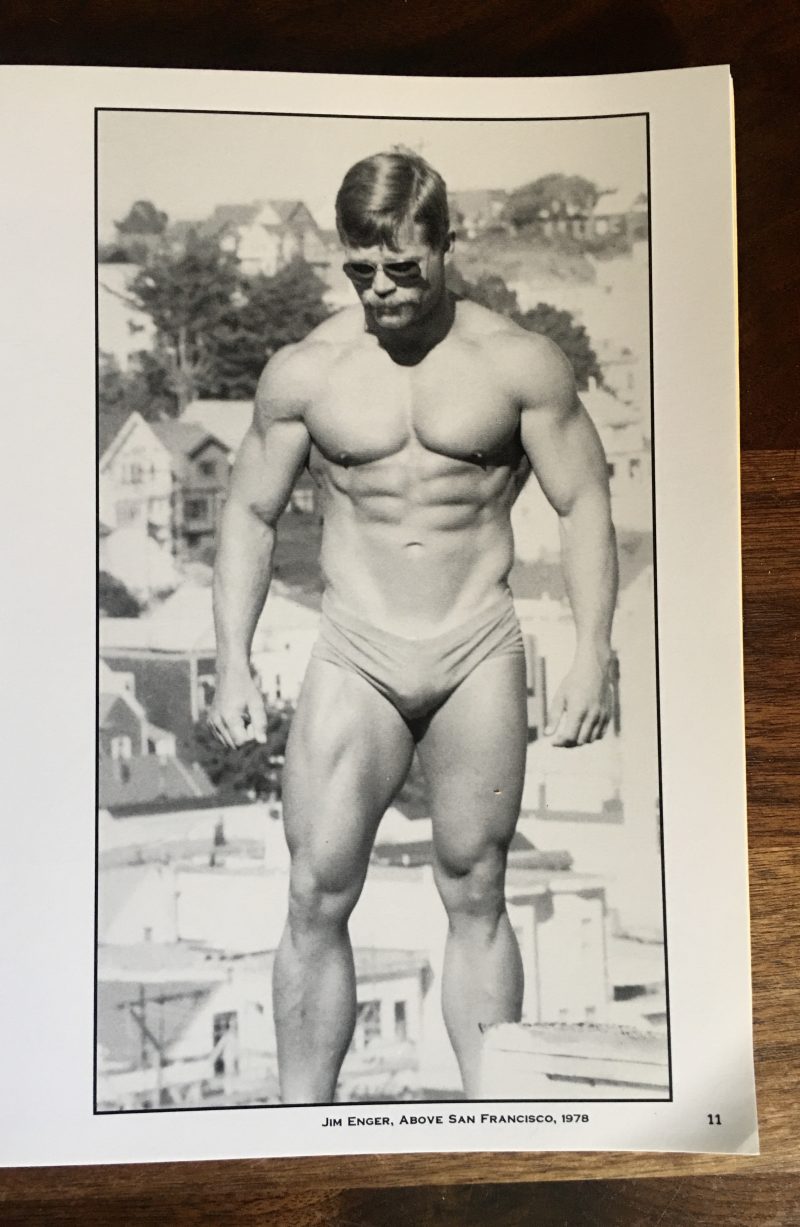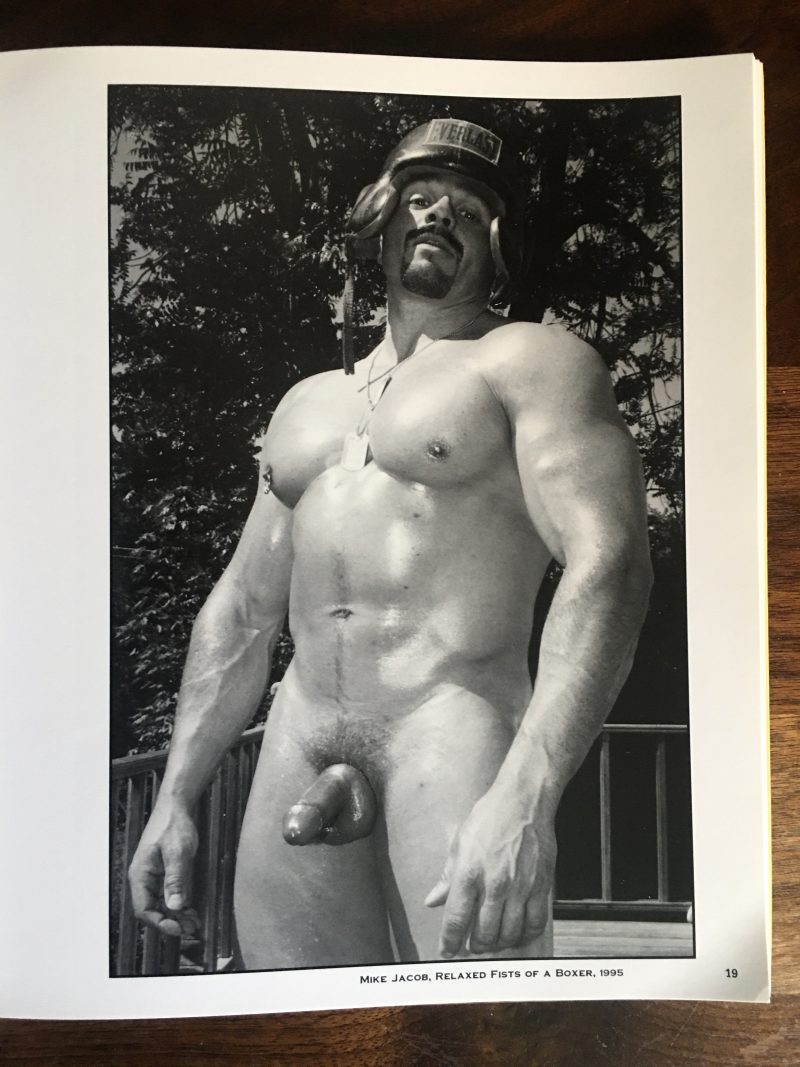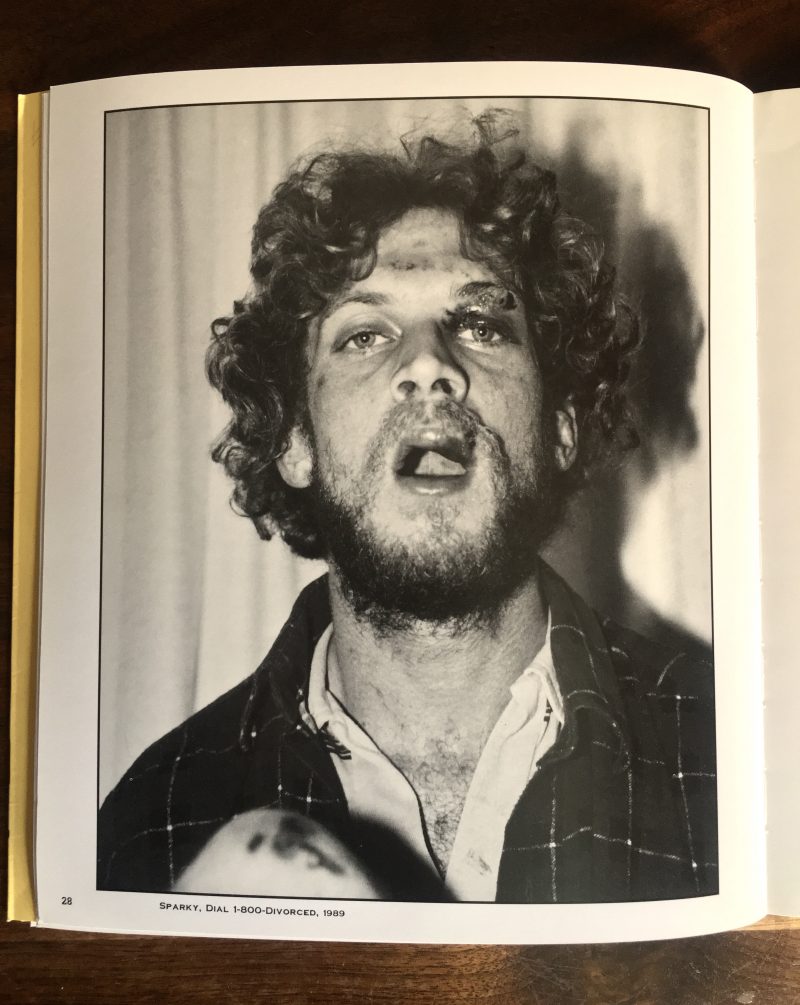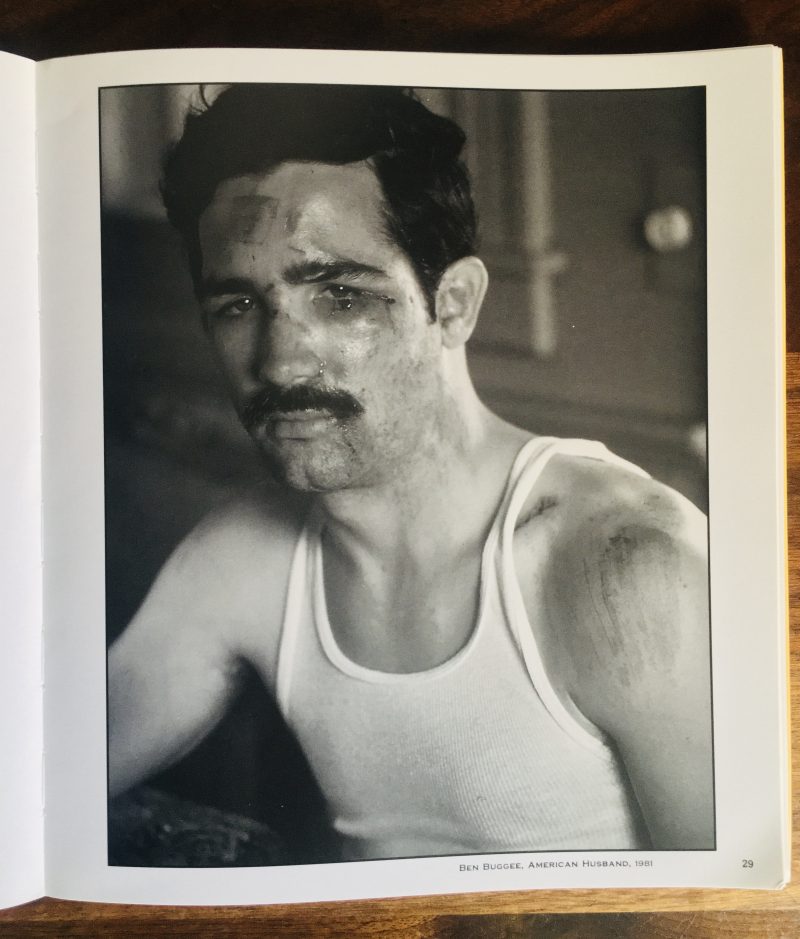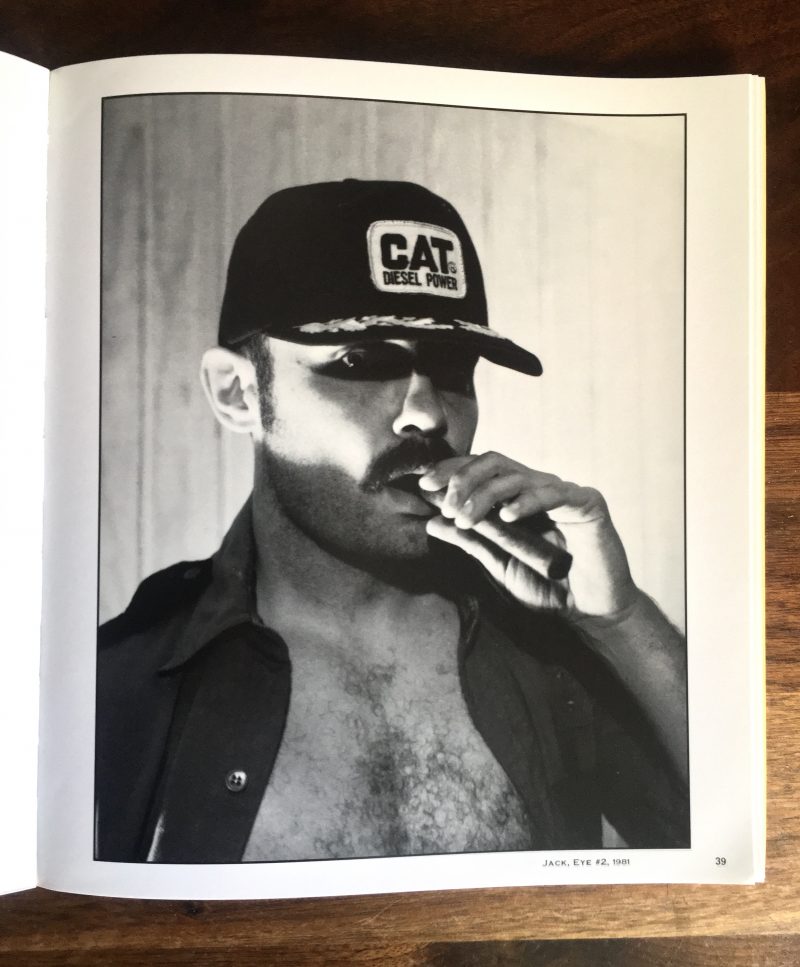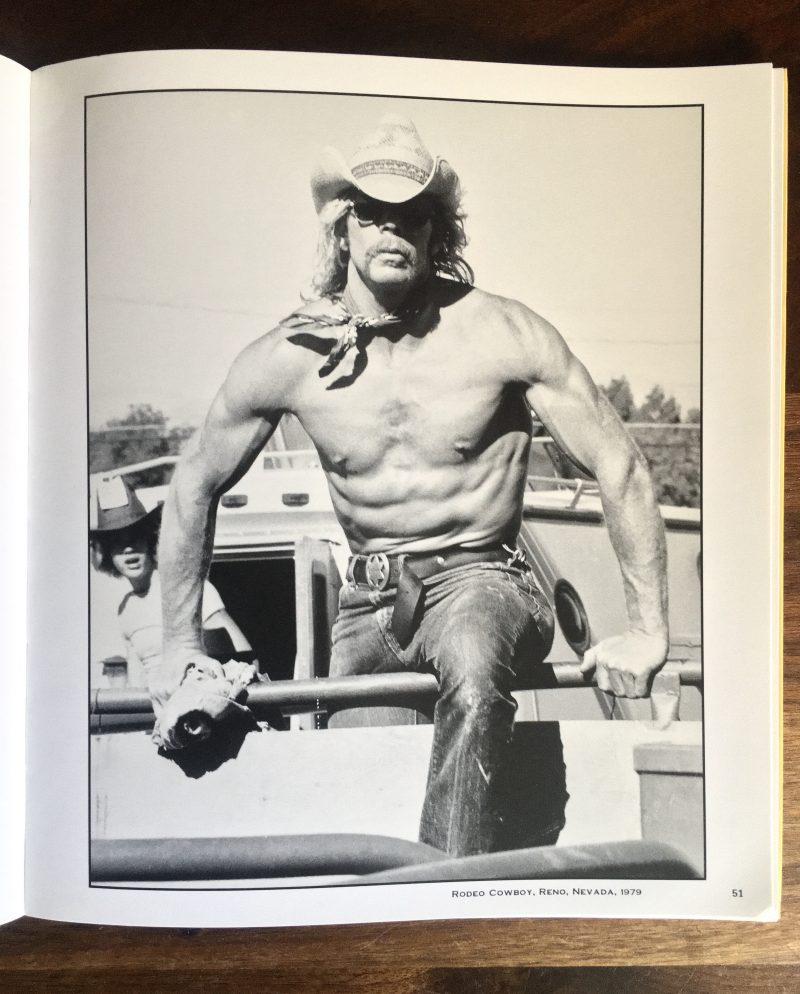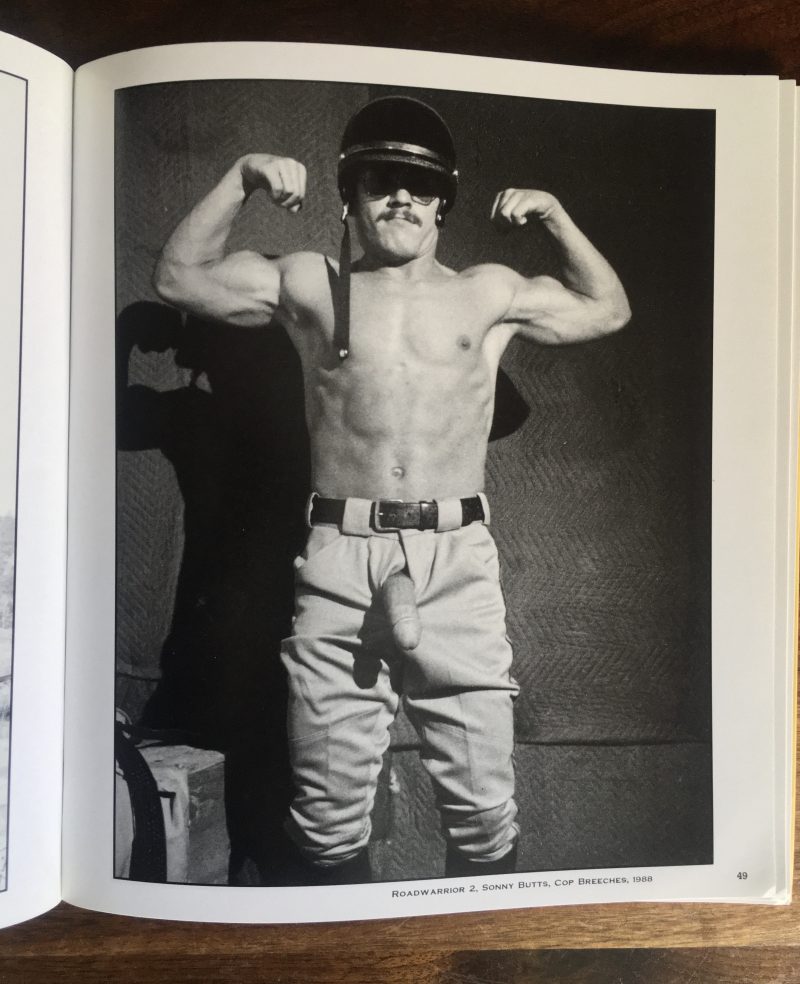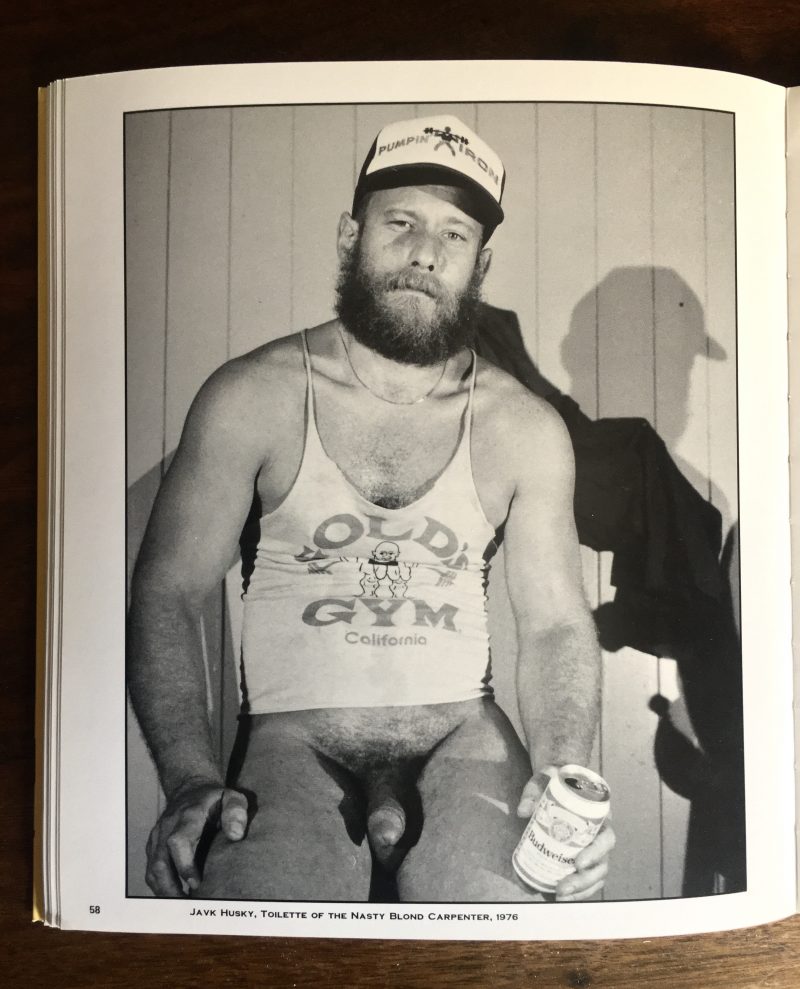SOLD. Jack Fritscher’s ‘American Men’ Photo Book 1995
Jack Fritscher’s ‘American Men’ Paperback.
JACK FRITSCHER’S AMERICAN MEN
A British Coffee-Table Photobook of American Images
60 Photographs, Shot During 25 Years
by JACK FRITSCHERPublisher : Heretic Books (July 1 1996) Measures 9 x 10 inches. Mint Condition.
Asking USD$35 + shipping from Canada..
SOLD
Book Review:
JACK FRITSCHER’S AMERICAN MEN (55 PHOTOGRAPHS OF MASCULINE MEN FOR LADIES AND GENTLEMEN WHO PREFER MEN MASCULINE). The ultimate, beautiful, masculine-identified coffee-table photo book you’ll want to keep under your bed. This is respectable art that has been known to provoke orgasm! 59 black-and-white photographs shot by Jack Fritscher.
Fritscher shoots hot men! Bears! Bodybuilders! Cowboys! Truckers! Young cops! Nudity, of course! YES! 4-Star reviews. Introduction by the prestigious British critic who brought you, from BRUSH CREEK MEDIA, the best-selling THE BEAR CULT photo book: Edward Lucie-Smith, the author of more than 30 books of art criticism, including: SEXUALITY IN WESTERN ART (1972 & 1971), ART TODAY (1996), and ARS EROTICA (1997). Includes naked full-page photographs of the real Mr America Chris Duffy/Sunset Bull, The Blake Twins, My Nephew/My Lover, Redneck Cowboy, Cowboy Bunkhouse Cigar, plus some artful bondage as well as smiling real men. NOTE: THIS IS A COMPLETELY DIFFERENT KIND OF MALE ART COFFEE-TABLE PHOTOGRAPHY BOOK, BECAUSE THERE ARE NO PICTURES OF MOUSSE-AND-CLONE GIRLYMAN MODELS LEANING IN SHADOWS HOLDING HULA-HOOPS. Each photograph is titled and thus contains its own kind of short-story. The photos actually relate to Fritscher’s many published books of fiction! So wonderfully hot, it had to be published in London.
From the Author
WATER FROM THE MOON (Ancient Japanese Saying Defining Something One Can Never Have)
On the title page of his dog-eared BILLY BUDD, Ryan wrote, in the most legible scribble of all his random notes, what must have come to him, suddenly, as a simple, illuminating, uninterrupted, crystal-line vision of sexual elegance.
That first night when I first saw Kick, I recognized one of life’s long shots at the Perfect Affirmation.
He was a man.
He had a man’s strength and fragility, a man’s grace and intensity, a man’s joy, and a man’s passion. He seemed my last chance to celebrate the changes i me as growth. He was so fully a man, he was an Angel of Light.
To him I could say nothing by YES.
One thing, you see, I know for sure: Nature very rarely puts it all together: looks, bearing, voice, appeal, smile, intelligence, artfulness, accomplishment, strength, kindness. That’s what I looked for all my life: the chance to say YES to a man like that.
I look in men for nothing more than that affirmative something that grabs you and won’t let you look away. Maintaining my full self, to have some plenty to offer back in balance, I’ve looked for some man who fills in the appropriate existential blanks, for some man to be the way a man is supposed to be, for some man to keep on keeping on with, in all the evolving variations of friendship and fraternity, beyond the first night’s encounter.
I’ve looked for that to happen: to be ale to say YES inside myself when a good, clean glow of absolute trust settles over the world.
Honest manliness is never half-revealed. When it’s there, it’s all right there in front of you. The hardest thing to be in the world today is a man.
Jack Fritscher Introduction to his photo book from his novel SOME DANCE TO REMEMBER
From the Inside Flap
Jack Fritscher has been many things: tenured university professor, novelist, writer of short stories, biographer, magazine editor, maker of more than two hundred videos, chronicler and critic of American pop culture–also (as this book demonstrates) skilled photographer. Many of these activities have been linked to an exploration of eroticism, which is, for Fritscher, an arena of masculine-identified sexuality. His approach is twofold. On the one hand he is the formally trained critic and ethnologist, curious about all aspects of human behavior. On the other, he is the writer- artist dramatizing a personal vision–the vision expressed for example in his ambitious novel, SOME DANCE TO REMEMBER. There, as here in these photographs, his focus is on what he calls “homomasculinity”–less the act of sex itself, more a complete state of being.
MUCH MORE:
JACK FRITSCHER’S AMERICAN MEN
Introduction by EDWARD LUCIE-SMITH
Jack Fritscher has been many things: tenured university professor, novelist, writer of short stories, biographer, magazine editor, maker of more than two hundred erotic videos, chronicler and critic of American pop culture – also (as this book demonstrates) skilled photographer. Many of these activities have been linked to an exploration of eroticism, which is, for Fritscher, an arena of masculine identified sexuality. His approach is twofold. On the one hand he is the formally trained critic and ethnologist, curious about all aspects of human behavior. On the other, he is the writer-artist dramatizing a personal vision – the vision expressed for example in his ambitious novel, Some Dance to Remember. There, as here in these photographs, his focus is on what he calls “homomasculinity”- less the act of sex itself, more a complete state of being.
He sees in the very male males who attract him – bodybuilders, cowboys, cops, men in various kinds of sports gear, men wearing military uniform – ritualized totems of the potent American Dream, taken from his own dream visions, as well as from the dreams of the intense cult following whose tastes he has recorded and reflected for many years on page and screen. He believes that, just as some women now legitimately investigate their own gender, so too many men have become increasingly curious about their own gender identification. In his view, true homomasculinity, far from cancelling out the female principle, offers the valid gender balance of male animus that the female anima demands and deserves. He notes that there is in male-to-male sex an underlying current of violence – that sexual relationships between grown-up men, the bulls of the herd, often veer towards displays of brute strength, and even beyond this, to episodes of direct physical competition. He also perceives that this kind of physical competition, these outbursts of destructive energy, are all intrinsic to the nature of American life – part and parcel of what was once, and not so very long ago, a lawless frontier society.
Though Fritscher was in fact one of the early generation of social humanists working on various frontiers of the American conscience — the Civil Rights Movement (beginning in 1961), the Peace Movement (1965), Gay Liberation (1967), these perceptions, feelings and preferences have increasingly tended to get him into hot water with the “politically correct”. The politically correct point of view is that feelings of the kind he reflects may, regrettably, exist, but ought not to be represented. Failure to represent such things will eventually, so current doctrine has it, lead to the abolition of what is deplored. There is a sad irony in the fact that the “gay” world, the realm of the queer or homosexual, has no sooner achieved recognition and to a certain extent legitimate status, than it begins to designate forbidden areas within its own territory. Fritscher’s images may be all the more threatening to a certain type of gay puritan because we immediately understand that to him they are familiar territory, not things encountered for the first time and recorded chiefly because they seem bizarre and startling. The late Robert Mapplethorpe once said that there was nothing shown in his own photographs that he hadn’t done himself. Fritscher can say the same, though with a subtly different nuance. A reminder of this is the more relevant because Fritscher and Mapplethorpe were once so closely linked personally, not only as friends but as lovers, protagonists in a stormy bi-coastal affair conducted just at the moment when Mapplethorpe was rising to the first peak of his reputation. It was Fritscher who commissioned Mapplethorpe to produce his first magazine cover, and who at the same time introduced him to the West Coast leather scene. This cover was done in 1977 for the San Francisco-based leather magazine Drummer, which Fritscher was then editing. Fritscher not only drew the design for it, but provided the model, Elliot Siegal.
Knowing this, one might look at Fritscher’s photographs expecting to find some trace of Mapplethorpe’s influence, though his own early photographic images were published when he was just eighteen, twenty years before he and Mapplethorpe encountered one another. In fact their approach is very different. Mapplethorpe’s most typical photographs are calculated, coolly staged, Deco artifacts where the subjects become objects, deprived of nearly all personality, frozen by the icy stare of the lens. Fritscher’s work is, by contrast, informal, candid, a product of the desire to seize and fix some epiphany, some magic moment, rather than to construct a particular pattern which already pre-exists in the photographer’s imagination. Some images are the result of Fritscher’s involvement with gay magazines and with video. These portray men who one time or another have been gay icons, and often show them at their most overtly sexual. Thus, there is a fine series of nudes of Don Russo, the ultra-macho star of a whole series of recent erotic videos, among them some made by Fritscher himself in collaboration with his partner Mark Thomas Hemry. Russo has a sexual electricity – Fritscher speaks of his “priapism” – which accounts for his impact in still photographs as well as on videotape. Photographing this phenomenon (the kind of fully independent personality Mapplethorpe usually seems to have avoided in his sexually oriented work) Fritscher seems to regard himself, not as someone who is imposing a stereotype, but as a collaborator with his subject. They are working together, one behind the camera, and one in front of it, to focus a particular set of qualities and characteristics, and give them their full effect. The same can be said of another photograph (p. 40), which is a full-length nude of Val Martin, star of the old SM classic, Born to Raise Hell. “We’re all motor-driven hacks compared with Robert as a photographer,” Fritscher has said, “but at least I’m not going to end up photographing lilies and leaves because I’m afraid, as Robert grew to be, of having somebody look back at me from the other side of the lens.”
Many of his photographs, in fact, are true candids, shot in public places, where the model or subject’s personal preference remains deliberately indeterminate. Fritscher often shoots on location, from the hip, and on the run. “I dare to stalk public events,” he claims, “Lying in wait for that magic moment when some man in a crowd looks directly at my raised camera and focuses on my lens with a “look”, a precise narrowing of the eyes, a look of bonding, superiority, surrender, even contempt. Any passion will do! Sexual inferences are drawn only because of my attitudes, as expressed in the photographs, and because of my gender. If I signed a woman’s name to these images they would be regarded very differently. “With Fritscher there is in fact no absolutely impermeable barrier between reality and erotic fantasy. There are certain kinds of activity which obsess him – bodybuilding, weight lifting, boxing, wrestling – because they seem to sum up the essence of masculinity, and also because they allow free rein to the kind of male narcissism which attracts him. He is always aware that the voyeur, in this case the man with the camera or the video camera, often fulfills the needs of the one who is observed, that the transaction, far from being one-sided, is fully reciprocal. He feels that many of the photographs taken in these circumstances – those of bodybuilders posing in contests or on the boardwalk at Venice Beach (pp. 8, 9) are just as erotically charged as those which are more overtly sexual. Even more charged, he might claim, because the relationship between the one who views and the one who is viewed is more complex and ambiguous than it is in circumstances where the sexual element is fully spelt out.
Fritscher admits, however, that the men he stalks in public invariably carry with them a strong sexual aura – and that this is the very aura which he is also trying to project when he photographs models in his studio. A case in point is the image of celebrated American bodybuilder Chris Duffy, wearing a tartan necktie. Here the model, far from being unaware of the camera, is working in collaboration with the photographer to project a particular image of himself. Even here, however, there are things the model cannot fully know. From start to finish of a shoot of this type, Fritscher is trying to peel away the masks his subject wears. The masculine self is revealed as well as the carefully constructed masculine image which both reinforces and partly conceals it. This unveiled process of co-creation is especially evident in Fritscher’s photographs of his long-time collaborator, the multi-titled bodybuilder Jim Enger (pp. 10, 11, 12). Enger takes on many guises – he is seen laughing disarmingly, but also as the straight Mr. IronMan which he was on the physique contest stage. Fritscher here, as in much of his work, both fictional and photographic, exerts a certain suspension of disbelief from the reader or viewer. There is a narrative present, but is it real or is it made up? Another case in point, but this time coming from the other, or “documentary” direction, is the superb image of a shirtless cowboy climbing a fence (p. 51). Is this pure documentary, or posed erotic choreography? One’s imagination is led by the startled look on the face of the woman behind and to the left of the subject. The narrative element in the photographs is reinforced in some cases by the fact that they were originally shot as stills during video productions directed by Fritscher and released by Palm Drive Studios. Some scenes are obvious fantasies, but the images nevertheless remain portraits to the same extent as the fantasy shots of celebrities made by Annie Leibowitz. They look, just as Leibowitz’s portraits do, in two directions: towards the fantasies of the subjects themselves, and towards the expectations (therefore also the fantasies) of the audience. Examples are the goggled truck mechanic in ‘Hand Gun’ (p. 25 – the same model is also seen on p. 31), the cowboy in ‘Last Cigar’, with hangman’s noose around his neck, and the prison bondage and medical fantasies (pp. 56, 57). These resemble Leibowitz’s work, but also have a kinship with the operatic extremism of Joel-Peter Witkin. In photographs of this type one is conscious that the line is blurred between fact and fiction, just as it is in Truman Capote’s “faction”, In Cold Blood, and in Woody Allen’s film Zelig. On occasion, the boundary between art and life dissolves altogether. ‘Bound and Hooded’, taken in August 1979, is a verite play shot of Larry Hunt, obviously made with the model’s consent and co-operation. Hunt later modelled formally for Robert Mapplethorpe. Later, in the 1980s, he was abducted from a Los Angeles leather bar. His fate was deduced from a single relic: a human jawbone, identifiable from dental records, which turned up long after his disappearance in Griffith Park in L.A. Fritscher’s photograph perhaps prophesies some aspects of he subject’s fate, but he cannot be held responsible for a series of events which took place after the image was made.
In a broader sense, the fact/fiction blur is one of the most important aspects of Fritscher’s work, and part of his truly original contribution to gay photography. With him, there is no absolutely impermeable barrier between asexual reality and erotic fantasy. There are pictures here where there is no specific element of sexual display, not even of the rather generalized sort which can be found in images of bodybuilders posing for the camera. Examples are the powerlifter (p. 44), a competitor in the Police Olympics, or the man in a kilt throwing the hammer (p. 62). Here the element of collaboration with the photographer may be presumed to be missing. The image is, in each case, the product of a single, fortunate never-to-be-repeated moment. It tells us nothing about the sexuality of the subject, but much about the image-maker’s own reactions to the world which surrounds him – the things he is attuned to, and is likely to notice and record. In “Butch – Hell’s Angels” (p. 35), for instance, Fritscher makes masculinity itself a fetish. There are pictures which revel in the ordinary sweat of life which is, by some twist of photographic magic, made special and extraordinary. Fritscher’s eye constantly perceives the world erotically. Guided by that eye, his camera picks out the ripe erotic sub-text which might otherwise remain unnoticed.
This, therefore, can be thought of as a book whose images are held together by an argument, or rather by a whole series of arguments, expressed through images rather than through words, about the nature of masculinity, and of male sexuality, within the wider framework of American society. It is, for example, about the way in which men present themselves sexually to the camera when they know they are being observed. Over the years, a whole series of conventions have been created, which are used when women present themselves in this fashion. The tendency in gay male photography has often been to adapt these for use with the male body – hence innumerable versions of the Playgirlmale nude, languorous and passively provocative. Fritscher knows that this pictorial grammar runs contrary to his purposes. He knows, too, that poses and pictorial conventions taken over from Greco-Roman statuary, beloved by quite a number of photographers working in this field, have a distancing effect, when what he wants to give is the closeness of the male, the scent and presence of masculinity, like a hunter stumbling upon a tiger in its jungle clearing. There are photographs here which go well beyond the boundaries of established conventions of male eroticism – frames captured from the flux of time, single never-to-be-repeated moments: a boxer taking a punch (p. 26), a young father who drove his car off the road (p. 28), a biker bloodied in a skid (p. 29). Such photos tell us nothing about the sexuality of the subject, but much about the image-maker’s reactions to the world, especially when placed within this particular context. It is Fritscher’s overall vision which makes them erotically charged.
“My portraits,” Fritscher once wrote, “define a certain kind of man in stasis and motion, in joy and pain, in the mutuality of sports and sex. Each is a single frame from an otherwise invisible movie. These are traditionally masculine men. Period. If one insists on politics, they are culturally traditional men surviving gender abuse in an age that trashes the legitimate male ethos. Found mostly on the streets, at construction sites, and at athletic events, these men – that is, their images – are presented without apology to provide comfort and joy to men and women who prefer masculine men in the best sense where power is not power over others, but is power in the disciplined control of oneself. Let me be quite clear. None of these images is pornographic. Pornography is wanting to control the object. Erotic art is loving the subject you want to behold, not possess. I’m very clear with these guys about keeping things pure. Few of these men actually ‘posed’ for the camera. Even when they were fully aware of its presence, they maintained their integrity without acting. That is precisely what I strive for. These are simply men, hopefully archetypic, celebrating masculine rites – of sport or sensuality, often mano-a-mano, offering themselves declaratively as athletes, adventurers, icons, saints, victims, survivors, and heroes, with the frailties and strengths to which all humans, regardless of gender, are heir.”
His work is not about men having sex with other men. It is about men exhibiting a sense of their masculine selves. Just for a moment, they are releasing the full power of their masculine natures. For Fritscher, a born observer and (as perhaps he would admit) a born voyeur, these images are irrefutable evidence of things which are latent in most men, and which, when the right moment comes, can be made to imprint themselves indelibly on a photographic negative, for everyone to see.
Edward Lucie-Smith Copyright 1995 Edward Lucie-Smith London, 1995
Edward Lucie-Smith was born in Jamaica and educated in Britain. He studied at King’s School, Canterbury and Merton College, Oxford and was an Education Officer in the RAF and an advertising copywriter before becoming a freelance writer. He is well known for his numerous art books, which include Movements in Modern Art since 1954 and Eroticism in Western Art. His more recent publications include 20th Century Latin American Art; Race, Sex, and Gender in Contemporary Art; Elisabeth Frink: A Portrait; American Realism; and Art Today.
SOLD.
